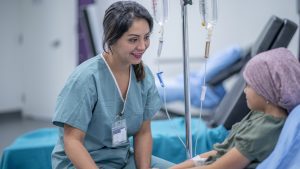
Lorna Rothery spoke to Parker Moss, Chief Partnership Officer at Genomics England about how the organisation’s Cancer 2.0 initiative is harnessing the potential of genomics to improve cancer care.
Cancer is one of the most common and complex diseases of our time, with approximately 18.1 million people affected worldwide.1 By definition, cancer involves the growth of abnormal cells in specific areas of the body which reproduce uncontrollably and can permeate and destroy normal body tissue. Given that cancer can affect thousands of genes across different cell types, the field of genomics is gaining recognition as a powerful tool for better understanding how genetic alterations can instigate the development of the disease.
As part of its aim to enhance understanding of the molecular complexity and evolution of cancer, Genomics England is harnessing the power of genomics and disruptive technologies in the hope that novel research and data can be translated into clinical practice and transform cancer care. To find out more about the organisation’s Cancer 2.0 initiative and how this cutting-edge programme could inform the future of cancer diagnostics and treatment, Lorna Rothery spoke to the programme’s lead and Chief Partnership Officer, Parker Moss.
What are the key objectives of the Cancer 2.0 initiative?
The Cancer 2.0 initiative is both a healthcare and research programme, therefore we have healthcare and research objectives. The healthcare objectives are to understand the clinical benefits of doing long-read and methylation sequencing in cancer and also understand the opportunity of introducing pathology and radiology imaging into clinical diagnostics. In addition to the clinical benefits, there are operational components to consider including the health economic value and the operational feasibility of implementing this technology within the NHS.
There are important research questions as well, such as whether the structural variation that can be revealed through long reads can help us predict the response to treatment, and prognosis of cancer patients. We also want to find out if those same predictions can be enhanced by adding imaging alongside genomes and then through that better reveal the mechanism of action in cancer biology.
Broadly speaking, what we are hoping to do with Cancer 2.0, in addition to the work we do in partnership with the NHS to diagnose cancer patients, is make sure that patients are pre-stratified so that they can be eligible for clinical trials and ultimately, therefore, increase the clinical trial participation in the UK.
I used to work in Great Ormond Street Hospital and am very focused on paediatric cancer. Often, paediatric conditions lag behind adult conditions in many areas of medicine, but in the case of genomics, paediatric cancer is really leading the way in whole genome sequencing, and we have had more enthusiasm and adoption from the paediatric cancer community than any other cancer. It is really nice to see that children in the UK are increasingly getting the deepest molecular profiling anywhere in the world, which is important.
Can you give an overview of how genome sequencing technologies can help improve approaches to cancer prevention, diagnostics, and treatment?
Cancer is a disease of the genome and understanding the molecular causes of oncogenesis is essential and interpretable by looking at aberrations in the genome. Some of those aberrations are druggable and by finding those druggable aberrations, and druggable mutations, we can more precisely treat patients.
We know that, on top of the molecular features of the tumour, there are spatial features that you can see through imaging which determine whether drugs will work successfully or not. For example, a major new and important class of drugs are immune checkpoint inhibitors, and we know that they work if your tumour presents specific molecular features like microsatellite instability. As well as molecular features, they also need to have a tumour microenvironment, which contains immune cells; you can see whether the microenvironment contains immune cells by looking at an image of the morphology of the tumour in the surrounding stroma. Combining those two insights can help us not only understand the biology of these cancers in more depth but also the particular molecular phenotype of a patient, and therefore, how to better treat them.

Often paediatric conditions lag adult conditions in many areas of medicine, but in the case of genomics, paediatric cancer is really leading the way in whole genome sequencing.
One area the cancer programme is looking at is long-read sequencing, what advantages does this technology offer over short-read sequencing and what could be the potential clinical impact for cancer patients?
We see these two technologies as very complementary today. It may well be that in the future they compete, but today, we see them sitting very well alongside each other. Short-read sequencing, which is dominated by Illumina globally, comprises a central lab model where we send all of our samples to a lab in Cambridge which does very high-quality sequencing. With long-read sequencing or nanopore sequencing, the devices are much smaller – about the size of a desktop printer – and they could potentially be placed at a hospital site, or at least in a lab hub much closer to the patient. The reason that matters operationally is the turnaround time. The time that it takes to get the result back to the patient matters, in some cancers more than others. For example, in acute myeloid leukaemia (AML), some molecular features need to be reported back to the patient within 24 to 48 hours and so reducing the travel time is a key advantage.
In terms of the scientific advantages, when you look at pathogenic variants – variants in the human reference genome – there are four classes to consider. There are single nucleotide variants, indels, which are insertions and deletions, copy number variants, and structural variants. In principle, short reads versus long reads are equivalent for two of those types, however, long-read sequencing is significantly more accurate on the structural variants, and today short-read sequencing is more accurate for indels. That is why we see them as complementary because we need both indels and structural variant analysis.
We already have very high-quality indel analysis from Illumina, so we understand the potential of indels and how they drive disease. However, because we do not have very good structural variation analysis we do not know whether structural variation is going to be a feature that either explains the biology or is potentially druggable, but there is a strong suspicion that it is. For now, ideally, we would have both long reads and short reads integrated so that we can measure all of the features of genomic instability and variation and understand the patient’s genome in as much detail as possible so that we can select the right drug and the right clinical trial.
It may well turn out that long-read sequencing is the superior way of doing all types of sequencing in the future, but we just do not know and that is why we are doing a major programme in collaboration with the NHS to study this.
What are the limitations that arise from looking at different data in silos and how will aggregating genomic data, imaging and pathology data inform better analysis?
Pathology and genetics are two areas requiring deep expertise and teams do not necessarily, naturally collaborate. Often, they work in different buildings, they have very different discussions, and they look at very different features of cancer. By physically integrating those classes of data (genomic, imaging, and clinical) we can bring the cultures of those specialities together and get them talking to each other. In doing so, we will generate insights about, for example, how the combination of the tumour microenvironment and molecular features integrate to drive the important things that you try to predict in medicine, which is the prognosis, response to treatment, and to a slightly lesser extent, toxicity. The challenge is that it has not been done before, this is really bleeding-edge science.
It is very much a Machine Learning field because in the molecular biology of the tumour we are looking at 3.2 billion base pairs, so it is a huge amount of data. Similarly, we are not just looking at a single slide, we are looking at a whole tumour block, so it may be 30 slides per tumour, per patient. These are very high-definition slides, and we are dealing with billions and billions of pixels. The real challenge is how, in a Machine Learning neural network, you integrate the pixels and the long string of text, in which ACGT is in, and analyse it in an integrated way. That is the data science challenge of multimodal Machine Learning programmes.
This has not been done before outside of academia, so we are really trying to do a world-first here, we will have by far the biggest whole-genome sequence and imaging database in the world, and we think this will generate insights into solid tumours. We very much see this as a research project, which should enable us to make better predictions about the response to treatment and prognosis, and also better understand the drivers of disease. Ultimately, we do expect this to have clinical importance and for these algorithms to help make predictions in the clinic. A nice example of that would be AstraZeneca and Daiichi Sankyo who came up with incredible new results for their antibody-drug conjugate Enhertu which is a breast cancer drug in which the biomarker is different levels of HER2. HER2 is measured in images today, using immunohistochemistry. In the past, patients were either HER2 positive or negative, but what this drug has shown is that actually, it is not just a binary thing, there is a spectrum, and the drug will work to a very specific threshold in that HER2 response. We now need to get much more accurate about measuring from an image the level of HER2 expression in triple-negative breast cancer tumours. That is a classic challenge that Machine Learning is very well suited to address.
Looking ahead, what are the key barriers that need to be overcome to translate cancer genomic research into clinical practice?
The historic limitation has been cost, but costs are coming down dramatically and we are in a very favourable cost curve. Equally, a lot of tools that people never thought would leave the research lab are now beginning to become affordable clinically.
The challenges include the huge resource constraints in the NHS, and this is everywhere, from porters to transport samples and pathology as well as clinical nurse specialists to consent the patients, because additional consent is required for this type of research. For pathology labs, the process for handling fresh frozen tissue that we need for whole genome sequencing is more complicated. Whole genomes produce a lot more variants and a lot more data – more than traditional targeted sequencing approaches. This has to be analysed by clinical scientists who work in the genomic lab hubs, they are very skilled people and there are not enough of them. We need to do more to train people and reward people like that.
Ultimately, we need to convince clinicians that there is a clinical value to the extra effort required to whole genome sequence their patients. Today, a lot of that value comes from patients participating in clinical trials, because drugs are not fully effective for the features that we are discovering, some of them are in standard care but there are not that many examples today. NTRK fusions are now druggable, if you look at phase one and phase two pipelines of the pharma companies and biotech across the next five years, there are hundreds and hundreds of drugs coming in this direction. Therefore, when clinicians see how many trial opportunities are going to be present in the next few years, we think they will be very enthusiastic to adopt this.
We have a big diversity programme at Genomics England, and it is particularly important because we know very well that some cancers, such as prostate cancer and breast cancer, particularly affect minority populations. The black population are significantly more affected by prostate cancer, and the Jewish population are particularly affected by triple-negative breast cancer BRCA mutations. We must understand both the genetic and the non-genetic drivers of those differences in prevalence.
We are racing to make sure that we have ironed out all of the operational, educational, and clinical governance challenges so that when the drugs are on the market, the UK population is ready to take advantage of this new kind of pipeline of therapeutics.
How do you think the field of cancer genomics will evolve in the future?
I think all cancers and many other diseases will be stratified and will be treated by genotype first. So instead of asking if someone has a specific type of cancer, the question will be whether they have EGFR cancer or K-ras cancer. The genotype will be the dominant feature that is driving clinical pathways.
As more and more people in the population are stratified, I think there will be more basket trials and more umbrella trials; instead of pharma companies having to provide IVD companion diagnostics to stratify their patients, those patients will be naturally stratified by the health system (NHS), and those patients will be able to participate in clinical trials and many patients will benefit from multiple trials or multiple drugs at the same time. For example, today, if you have breast cancer, you may be eligible for a PARP inhibitor. You may also be eligible for a checkpoint inhibitor, which requires microsatellite instability, or an AKT inhibitor which requires a PIK3CA mutation, and you actually may be eligible for all three at the same time which is rare but not unheard of. When we have a single test that can sequence all patients, we will be able to pick up not just one, but multiple biomarkers and make sure that patients are optimally drugged.

We will have by far the biggest whole genome sequence plus imaging database in the world, and we think this will generate insights into solid tumours.
Another change is that we will be sequencing people not just at diagnosis but longitudinally and continually throughout their treatment pathway and that will be very important for identifying recurrence. For patients that go into remission, the challenge is to detect recurrence early, and then also to know how recurrence has changed from their frontline sequence because tumours are heterogeneous, and that heterogeneity is evolving over time. Often, that evolution is driven by frontline treatment, so it is important to know if the patient’s tumour has changed after they have had their first year of treatment so that you know how to adapt your therapeutic pathway.
Early detection is going to be a major change in the way that we screen for cancer. The big and exciting thing that everyone is focused on is not just screening for a single cancer type but pan-tumour screening. There is a strong and compelling vision that every adult every year will have a simple blood test that will tell them two things, not just that they have elevated cancer markers, but where those markers are coming from – the tissue of origin. By doing so, we can then follow up and image those patients and look for potential early-stage lesions. The real opportunity there is to generate a stage shift from catching patients at stage four to capturing more patients at stage one in which case survival curves are way better; 80% survival versus 20%.
Imaging is just one modality, there are other modalities like proteomics where you are not looking at the DNA, but at the proteins that are transcribed through RNA from gene expression into actual proteins, often expressed on the cell surface. Proteomics is really a research tool to understand cancer biology, but it has no role in the clinic because it is too expensive and too slow. But I expect in the coming years that other modalities like proteomics, whole-genome methylation, transcriptomics, and imaging and maybe even in the longer term, single-cell sequencing, will be new microscopes that can be used alongside DNA sequencing in the clinic to offer greater precision in terms of reading the genome.
Looking ahead to the next five to ten years, I really do think that autologous therapies, which have sometimes been called cancer vaccines, are going to be increasingly viable. Using the aforementioned technologies, we can look at new antigens which are unique markers on the surface of patients’ tumours and analyse them in the lab. This process is autologous, we will be able to edit and manipulate and then expand their immune cells and put them back in the patient’s body to help them attack their very own cancers, and those cells will survive in the body to provide long-term, durable resistance to future cancers that they have exhibited. I actually do think that is a very feasible vision on the five to ten-year horizon.
First, we are going to improve the way we read the cancers, and then we will essentially be writing by editing patients’ immune cells and having them do the work traditionally done today by chemotherapy and radiotherapy.
References
Parker Moss
Chief Partnership Officer and leader of the cancer programme at Genomics England
Non-Executive Director on Cancer Research UK’s horizon board
https://www.genomicsengland.co.uk/
https://www.linkedin.com/company/genomics-england
https://www.facebook.com/genomicsengland/
https://twitter.com/genomicsengland
https://www.instagram.com/genomicsengland/
https://www.youtube.com/c/GenomicsEngland
This article is from issue 23 of Health Europa Quarterly. Click here to get your free subscription today.









